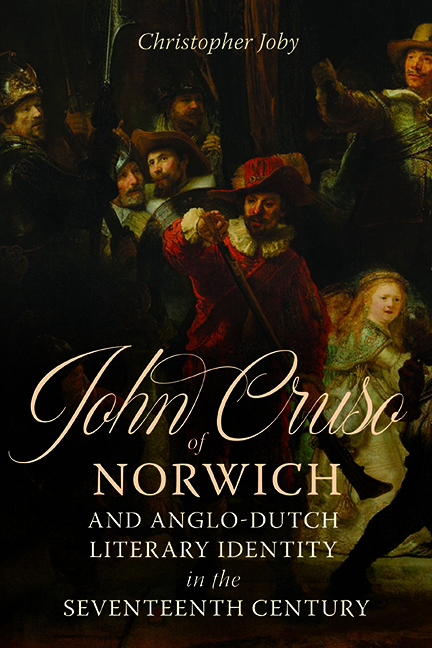Book contents
- Frontmatter
- Dedication
- Contents
- List of illustrations
- Acknowledgements
- Author’s note
- Abbreviations
- Prologue
- 1 Intrat John Cruso
- 2 John Cruso’s school days
- 3 John Cruso’s early adult life
- 4 Cruso’s elegy to Simeon Ruytinck (1622)
- 5 Cruso the English poet
- 6 1632 – Cruso’s annus mirabilis
- 7 Cruso the translator
- 8 Cruso’s 1642 Dutch verses: praise and lamentation
- 9 Cruso and the English Civil Wars
- 10 Cruso the Epigrammatist
- 11 Cruso’s final years
- Epilogue
- Appendix 1 Poems by John Cruso
- Appendix 2 Liminary verses in John Cruso’s English publications
- Bibliography
- Index
- Studies in Renaissance Literature
- Frontmatter
- Dedication
- Contents
- List of illustrations
- Acknowledgements
- Author’s note
- Abbreviations
- Prologue
- 1 Intrat John Cruso
- 2 John Cruso’s school days
- 3 John Cruso’s early adult life
- 4 Cruso’s elegy to Simeon Ruytinck (1622)
- 5 Cruso the English poet
- 6 1632 – Cruso’s annus mirabilis
- 7 Cruso the translator
- 8 Cruso’s 1642 Dutch verses: praise and lamentation
- 9 Cruso and the English Civil Wars
- 10 Cruso the Epigrammatist
- 11 Cruso’s final years
- Epilogue
- Appendix 1 Poems by John Cruso
- Appendix 2 Liminary verses in John Cruso’s English publications
- Bibliography
- Index
- Studies in Renaissance Literature
Summary
1632 was a signal year for John Cruso of Norwich. In this, his fortieth year, his eldest son, John Jr., matriculated at Cambridge, a rite of passage that he himself had not undergone. To mark this event, and perhaps as a token of his gratitude, John Sr. presented John Jr.'s college, Gonville & Caius, with a copy of a book that he published in this same, significant year. In his own hand John Sr. added the words ‘Ex dono Johis Cruso Gener: & Mercatoris Norwicensis’. Writing in Latin he could communicate that although he had not enjoyed a university education, he was still able to use the language of prestige and learning in early modern Europe. He identifies himself as a merchant [mercator], for he had taken over the family cloth and hosiery business from his father along with his rights as a freeman. A measure of his success in commerce was that in 1624, he had taken on an apprentice, Thomas Palgrave, who gained his own freedom as a hosier in 1632. Cruso also describes himself as Gener[osi], i.e., a gentleman, reflecting the fact that by his fortieth year he had achieved a respectable position within English society. He concludes with a reference to his hometown, Norwich, the second city of late Tudor and early Stuart England. Cruso added the city of his birth to his signature elsewhere, and he identified with it closely.
The book, Militarie Instructions for the Cavallrie, was one of the first works in English to provide instructions on how cavalrymen should prepare for and engage in combat. Up to the beginning of the seventeenth century, England was primarily a country of infantrymen, but as the century progressed, the cavalry would play a more significant role in English military activity. As an author Cruso was to some extent an agent of this change. A second edition of Militarie Instructions was published in 1644 when England was in the throes of the First Civil War. It has been described as ‘the most renowned of early English works on cavalry’, a claim that gains strength when we learn that leading figures in the war, such as the Royalist politician and soldier, Sir Gervase Clifton (1587–1666), and the commander-in-chief of the New Model Army, Sir Thomas Fairfax (1612–71), may have owned copies.
- Type
- Chapter
- Information
- Publisher: Boydell & BrewerPrint publication year: 2022



